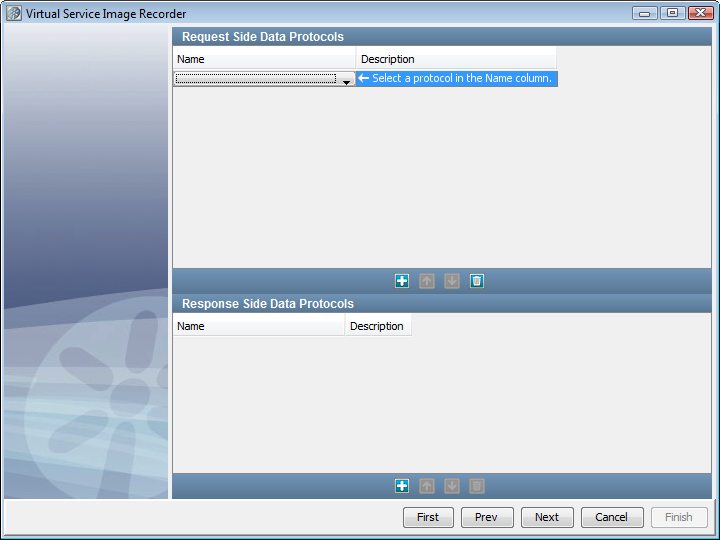

The second window in the Virtual Service Image Recorder wizard lets you enter information about data protocols for the virtual service.

The recorder can use the following data protocol handlers. Choosing the appropriate data protocol helps the recorder to analyze the information it records to differentiate the conversations and identify transactions belonging to the conversations. You can chain these data protocol handlers to use them with each other.
Identifies a message by the hash code of the data. The hash code changes with even a slight change in the data, which effectively makes all requests unique. This protocol is useful if you run the same small set of requests against the service.
Splits the recorded request into its respective container chunks. It then sends each chunk to the Copybook data protocol and aggregates the corresponding XML.
Converts copybook text to XML.
Splits the recorded request into its respective container chunks. It then sends each chunk to the Copybook data protocol and aggregates the corresponding XML.
Tries to recognize sensitive data and substitute random values during the recording. For more information, see Desensitizing Data.
Converts delimited strings to XML.
Converts binary DRDA payloads to XML during recording to facilitate alignment with native DevTest functionality, readability, and dynamic data support. Converts responses back to their native format on playback.
Transforms ANSI X12 EDI documents to an XML representation in the body of the request.
Identifies whether the requests and responses are XML strings. If you use this protocol, you can identify variables in the XML messages that the recorder uses.
Converts JSON data to an XML equivalent and converts XML data to JSON format.
Copies data from the current inbound request into the current testing context.
Manipulates VSE requests as they are recorded or played back.
Analyzes HTTP requests that follow the REST architectural style
Provides scripts on the request side, the response side, or both, to process the request or response.
Converts SWIFT messages to an XML equivalent and converts XML data to SWIFT messages.
Applies only to the DevTest Travel example. You can ignore this data protocol because it is specific to the example and is not useful in a general case.
Applies to use by a web service client.
Converts SOAP header elements into request arguments.
Strips security from the SOAP Request before sending it along the Virtualize framework and applies security to outgoing SOAP responses.
Converts an XML document into a proper operation/arguments type of request.
Note: JDBC does not allow a data protocol.
For more information about these data protocols, see "Using Data Protocols".
For more information about using a dynamic data protocol, see "Generic XML Payload Parser".
|
Copyright © 2014 CA Technologies.
All rights reserved.
|
|